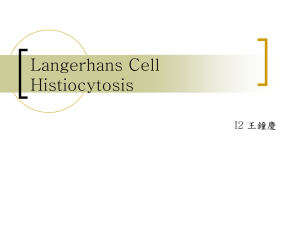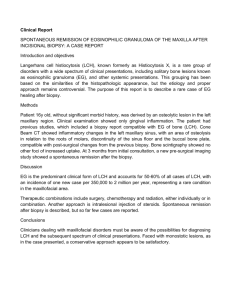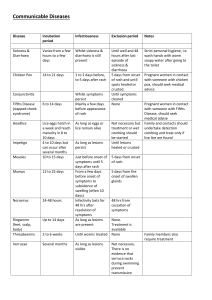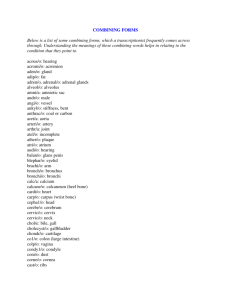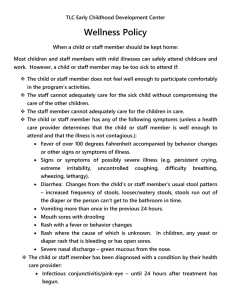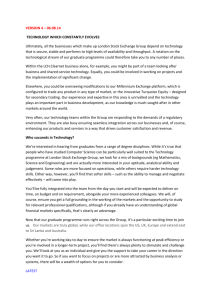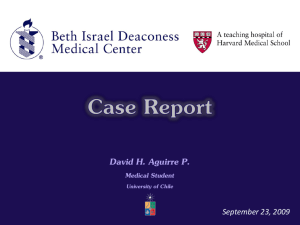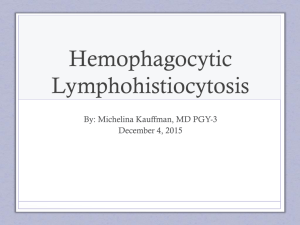Hemophagocytic Lymphohistiocytosis (HLH)
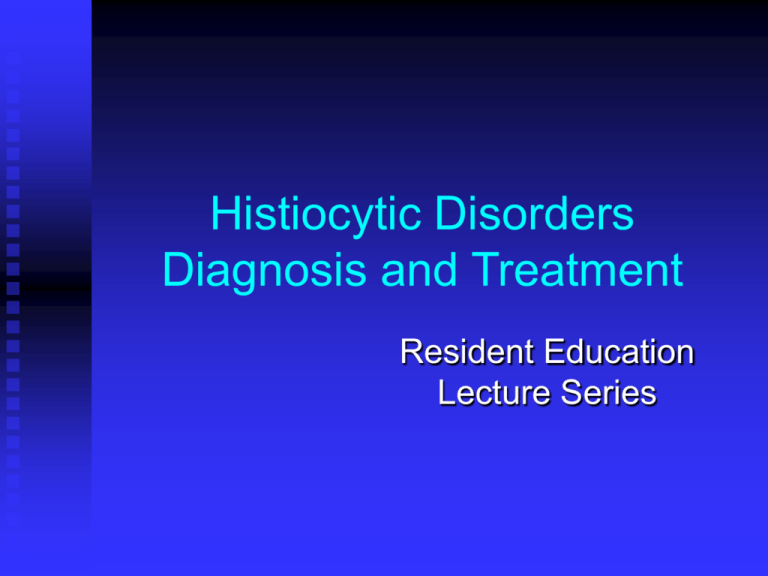
Histiocytic Disorders Diagnosis and Treatment
Resident Education Lecture Series
Histiocytosis
Group of Disorders Clonal proliferation of cells of mononuclear phagocyte system (histiocytes) Histiocyte- central cell Form of a WBC
Classes of Histiocyte Disorders
Class I Langerhans cell histiocytosis Class II Non-Langerhans cell histiocytosis Hemophagocytic Lymphohistiocytosis (HLH) Class III Malignant Histiocytic Disorder
Class I: Langerhans Cell Histiocytosis (LCH)
Other names: Histiocytosis-X Eosinophilic granuloma Hand-Schüller-Christian syndrome Letterer-Siwe disease
LCH
LCH can be local and asymptomatic, as in isolated bone lesions, or it can involve multiple organs and systems with significant symptomatology and consequences Thus, clinical manifestations depend on the site(s) of the lesions, the organs and systems involved, and their function(s) Restrictive vs. Extensive LCH
Restricted LCH
Skin lesions without any other site of involvement Monostotic lesion with or without diabetes insipidus, adjacent lymph node involvement, or rash Polyostotic lesions involving several bones or more than 2 lesions in one bone, with or without diabetes insipidus, adjacent lymph node involvement, or rash
Extensive LCH
Visceral organ involvement +/- bone lesions, diabetes insipidus, adjacent lymph node involvement, and/or rash without signs of organ dysfunction of the lungs, liver, or hematopoietic system Visceral organ involvement +/- bone lesions, diabetes insipidus, adjacent lymph node involvement, and/or rash with signs of organ dysfunction of the lungs, liver, or hematopoietic system
LCH-diagnosis
S100 protein CD1 antigen Birbeck granule positive cells by Electron Microscopy
LCH- sites of involvement
Skin (rash) Bone (single or multiple lesions) Lung, liver and spleen (dysfunction) Teeth and gums Ear (chronic infections or discharge) Eye (vision problem or bulging) CNS (Diabetes Insipidus) Fever, weakness and failure to gain weight
Bone involvement
Bone involvement is observed in 78% of cases and often includes the skull 49%, innominate bone 23%, femur 17%, orbit 11%, and ribs 8%. Single or multiple lesions.
Vertebral collapse can occur.
Long bone involvement can induce fractures.
Skull lytic lesions with LCH
Characteristic rash of LCH
Characteristic Scalp Rash with LCH
LCH TREATMENT
Localized disease-skin, bone, lymph nodes Good prognosis Minimal/no treatment Localized skin lesions, especially in infants, can regress spontaneously If treatment is required, topical corticosteroids may be tried Intralesional steroids
LCH Treatment-Extensive
Multiple Organ disease Benefit from chemotherapy and/or steroids 80% survival using prednisone, 6MP, VP16 or vinblastine (Velban ™).
If you do not respond to chemotherapy in the first 12 weeks 20% survival.
Sinus histiocytosis with massive lymphadenopathy: Rosai-Dorfman disease
A persistent massive enlargement of the nodes with an inflammatory process characterizes this condition. The disease rarely is familial
Rosai-Dorfman disease
The male-to-female ratio is 4:3, with a higher prevalence in blacks than in whites. Fever, weight loss, malaise, joint pain, and night sweats may be present. Cervical lymph nodes Other areas, including extranodal regions, can be affected.
These disorders can manifest with only rash or bone involvement
Rosai-Dorfman disease
Immunologic abnormalities in conjunction with the disease can be observed Leukocytosis; mild normochromic, normocytic, or microcytic anemia; increased Immune globulins (Igs); abnormal rheumatoid factor; and positive lupus erythematosus
Treatment
The disease is benign and has a high rate of spontaneous remission, but persistent cases requiring therapy have been observed
Class III: Malignant Histiocytic Disorders
True neoplasms Extremely rare Acute monocytic leukemia, malignant histiocytosis, true histiocytic lymphoma Symptoms fever, wasting, LAD, hepatosplenomegaly, rash Treatment Induction prednisone, cyclophosphamide, doxorubicin Maintenance vincristine, cyclophosphamide, doxorubicin
Class II:HLH
Underlying immune disorder Uncontrolled activation of the cellular immune system Defective triggering of apoptosis Incidence 1.2/ 1,000,000 M=F Age: Familial: usually present < 1yr Secondary: may present at any age
HLH
Familial Hemophagocytic Lymphohistiocytosis (FHLH) Primary HLH Infection Associated Hemophagocytic Syndrome (IAHS) Secondary HLH
Familial HLH
FHLH, FHL, FEL Hereditary transmitted disorder Autosomal recessive Affects immune regulation Family history often negative Triggered by infections Presence of perforin gene mutation leads to deficiency in triggering of apoptosis Only 20-40% of familial HLH have perforin mutation H-Munc 13-4 (17q25) discovered 2003 assoc FHLH
Perforin
Membranolytic protein expressed in the cytoplasmic granules of cytotoxic T cells and NK cells.
Responsible for the translocation of granzyme B from cytotoxic cells into target cells; granzyme B then migrates to target cell nucleus to participate in triggering apoptosis.
Without perforin, cytoxic T cells & NK cells show reduced or no cytolytic effect on target cells.
Infection-associated HLH
VAHS Develops as the result of infection Viral (most common), bacterial, fungal, parasites Often in immunocompromised hosts (HIV, oncologic, Crohn’s disease)
Clinical Presentation
Fever Hepatosplenomegaly Neurological symptoms (seizures) Large lymph nodes Skin rash Jaundice Edema
CNS disease
CNS infiltration most devastating consequence(s) of HLH Seizures Alteration in consciousness-coma CNS deficits-cranial nerve palsies, ataxia Irritability Neck stiffness Bulging fontanel
Laboratory Abnormalities
Cytopenias (Platelets, Hgb,WBC) High Triglycerides Prolonged PT, PTT, low Fibrinogen High AST, ALT CSF- high protein, high WBC Low Natural Killer cell activity High Ferritin
Histopathological Findings
Increased numbers of lymphocytes & mature macrophages Prominent hemophagocytosis Spleen, lymph nodes, bone marrow, CNS
Diagnostic Criteria
Clinical criteria: fever, splenomegaly .
Laboratory Criteria Cytopenia (> 2 of 3 cell lines) Hgb < 9 gm/dl, plts < 100, anc < 1000 High triglycerides age) +/ (> 3SD of normal for low fibrinogen (<150) Pathology Criteria hemophagocytosis or lymph nodes - bone marrow, spleen No evidence of malignancy
Additional Laboratory Criteria
CSF-high WBC, high protein Liver-histiological- chronic persistent hepatitis Low Natural Killer Cell activity Familial etiology cannot be determined in first affected infant
Treatment
Without treatment FHLH is rapidly fatal Median survival- 2 months
HLH Pts If 2 nd HLH 8 wks chemo Treat cause of immune reactivation If persistent consider 1st HLH Familial Disease Continuation therapy, BMT if donor Persistent non-familial Continuation therapy, BMT if donor Resolved non-familial Stop therapy Reactivation Continuation therapy, BMT if donor
Treatment
Initial therapy (8 weeks)-induction Decadron (8wks), CSA VP16 (2x/wk x 2 wks, 1x/wk x 6wks) ITM and steroids if CNS disease is present after 2 wks of therapy for 4 doses In non -familial cases treatment is stopped after 8 weeks if complete resolution of disease
Treatment
Continuation Therapy Week 9-52 VP16 every other week Decadron pulses every 2 wks for 3 days CSA (level 300) QD
Bone Marrow Transplant
In FHLH BMT - only curative therapy BMT performed ASAP: acceptable donor disease is non-active Non-familial disease BMT offered at relapse
HLH-94 Protocol Results
113 patients treated on protocol 56% (63/113) alive at median 37.5 m.
3 year OS 55% +/- 9% BMT patients (n=65) 3 year OS 62% Only 15 /65 patients had matched related donors. The majority were unrelated.
From ABP Certifying Exam Content Outline
Histiocytosis syndromes of childhood
Recognize the clinical manifestations of childhood histiocytosis syndromes
Credits
Julie An Talano MD
